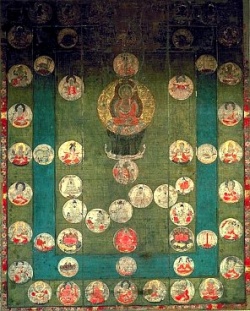Hokuto Mandala
Hokuto Mandala 北斗曼荼羅. Big Dipper Mandala. Used when performing the Hokutohō 北斗法 or "Big Dipper Rite" for averting natural disasters and calamities. Classified as a Besson Mandala dedicated to specific deities. Although also classified as a type of Hoshi (Star) Mandala -- ones that represent the deification of heavenly bodies -- the Hokuto Mandala is primarily centered on a single deity named Ichijikinrin Butchō 一字金輪仏頂 (see Ichijikinrin Mandala), who commonly assumes the form of Shaka Kinrin 釈迦金輪 (Gold Wheel Shaka) in artwork. Shaka Kinrin is a manifestation of Shaka Buddha 釈迦如来 (the Historical Buddha), one in which Shaka is holding a golden wheel in his hands, with the wheel placed on the lap and the hands forming the Hokkai Jōin Mudra 法界定印 (dharma-realm meditation mudra). In the Hokuto Mandara, Shaka Kinrin is often shown surrounded by the seven stars of the Big Dipper, by the nine planets, by the 12 signs of the Zodiac, and by the deities of the 28 lunar mansions. The Tendai 天台 sect uses a circular mandara (a renowned example is preserved at Hōryūji Temple 法隆寺 in Nara, while the Shingon 真言 Sect uses a square mandara (preserved at Kumedadera 久米田寺 in Osaka). See photos of both on our Mandala Glossary page. The disposition of the deities varies somewhat. Some variants of the Hokuto Mandara include the Myōken Mandara 妙見曼荼羅 centered on Myōken Bodhisattva 妙見菩薩 (Jp. = Bosatsu), the Tōhon Hokuto Mandala devoted to Shijōkō Butchō 熾盛光仏頂, and the Taoist-influenced Shūnanzan Mandara 終南山曼荼羅.
Painting on right
28 deities in outer frame, 12 zodiac signs in middle frame, with days & planets and main deity in central frame. Ichijikinrin Butchō 一字金輪仏頂 at center. Ichijikinrin (aka Shaka Kinrin) is another form of Shaka (Historical Buddha). Photo this J-site.
DESCRIPTION. Says the Kyoto National Museum: "Under the central Buddha are seven medallions shaped like an "S" turned on its side, or a scoop. Inside each medallion is a figure wearing a headdress. These are the Seven Stars of the Big Dipper, the most important stars in the Star Mandala. They are shaped like this to represent the constellation of the big dipper. Other medallions in the center section represent planets such as Mercury, Venus and Saturn, and the Sun and Moon."
